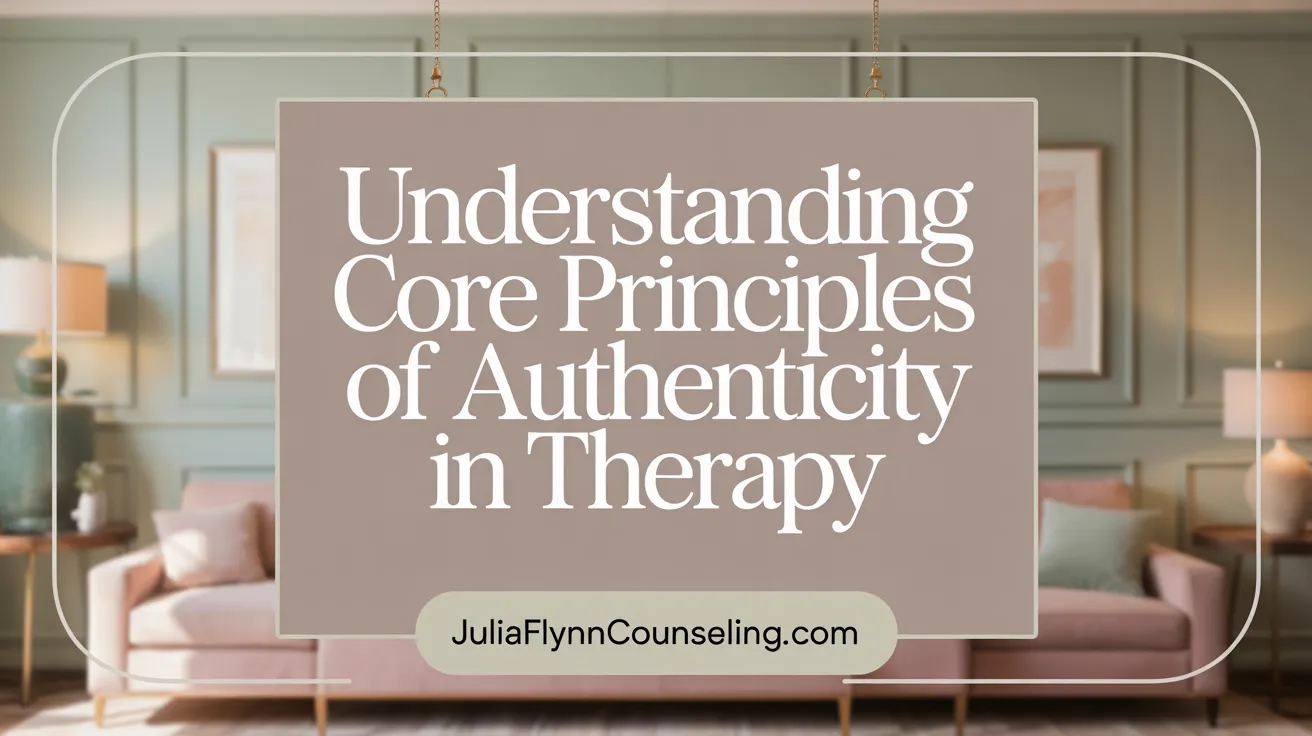The Cornerstone of Healing: Why Authenticity Matters in Therapy
Authenticity within therapy is more than an approach — it is the foundational element that fosters trust, safety, and deep connection between therapist and client. When therapists engage genuinely, bringing congruence between their inner experiences and outer presence, they create a safe haven for clients to explore emotions, vulnerabilities, and growth potential. This article explores the multifaceted role of authenticity in therapeutic relationships, revealing how it cultivates effective outcomes and meaningful human connection.
Defining Authenticity in Therapy: Core Principles and Meaning

How is authenticity defined in the context of therapy, and what are its core principles?
In therapy, authenticity refers to the therapist’s ability to genuinely express their inner thoughts, feelings, and reactions in a manner that is consistent with their true self. It involves showing up sincerely in the therapeutic space, fostering trust and openness. This genuine expression must be balanced with maintaining professional boundaries to ensure the safety and well-being of the client.
The fundamental principles guiding authenticity include honesty, transparency, and self-awareness. Therapists are encouraged to be truthful about their reactions and to communicate openly while being mindful of ethical limits. Self-awareness allows therapists to understand their emotional responses and biases, which in turn enhances their ability to be present and authentic.
This active process involves continuous reflection—therapists regularly evaluate whether their behavior, words, and attitudes align with their core values and the needs of their clients. It also entails managing one’s emotions and practicing attunement to foster genuine connections.
Authenticity in therapy nurtures a safe and supportive environment where clients feel truly heard and understood. It promotes deeper engagement, facilitates trust, and enhances the healing process. For therapists, practicing authenticity contributes to their professional satisfaction and mental well-being, reducing burnout and fostering ethical, meaningful care.
Overall, authentic therapy is not about revealing everything but about being deliberately real, present, and honest, thereby creating a space where clients can explore their inner selves with confidence and trust.
The Transformative Impact of Authenticity on Therapeutic Relationships and Outcomes

What is the significance and impact of authenticity in therapeutic relationships?
Authenticity in therapy is crucial because it builds the foundation for trust, rapport, and emotional safety. When therapists are genuine, transparent, and present, clients feel more understood and are willing to open up about their vulnerabilities. This openness encourages deeper engagement and motivation, which are vital for effective treatment.
An authentic therapeutic relationship serves as a model of honesty and self-acceptance, inspiring clients to reflect on their own truths and develop resilience. Maintaining authenticity, while respecting professional boundaries and cultural backgrounds, ensures that the relationship remains ethical and empowering.
Research indicates that genuine interactions between client and therapist significantly influence therapy success. Such relationships lead to better adherence, more meaningful progress, and positive long-term outcomes. In sum, authenticity enhances the therapeutic process by fostering an environment of mutual trust and respect.
How does authenticity contribute to building trust, rapport, and effective therapy outcomes?
Authenticity plays a central role in establishing trust and rapport in therapy. When therapists openly demonstrate honesty and empathetic engagement, clients are more likely to feel safe sharing their thoughts and emotions. This sense of safety boosts emotional safety, which is critical for self-exploration and vulnerability.
This genuine connection strengthens the therapeutic alliance—the collaborative and trusting bond essential for effective therapy. As a result, clients tend to be more motivated, compliant, and engaged in the treatment process.
Research shows that authentic, respectful interactions are especially valuable for clients with histories of trauma or marginalization, as they promote trust where it may have been previously lacking. Ultimately, the authenticity of the therapist directly influences therapy outcomes by creating a supportive environment conducive to healing.
In what ways does authenticity influence client engagement, healing, and progress in therapy?
Authentic interactions foster a sense of safety and acceptance, encouraging clients to fully participate in therapy. When therapists embody authenticity—being honest, present, and aligned with their values—they help clients feel understood and supported.
This trust and emotional safety lead to deeper self-exploration, enabling clients to confront difficult feelings and develop insight. A strong therapeutic alliance rooted in authenticity is associated with increased motivation, reduced dropout rates, and more sustained engagement.
Moreover, authentic relationships model vulnerability, encouraging clients to mirror this honesty within themselves. Over time, this openness facilitates emotional healing, resilience, and meaningful personal growth.
| Aspect | Impact | Details |
|---|---|---|
| Building trust | Facilitates openness | Genuine interactions promote honesty and safety |
| Enhancing rapport | Strengthens connection | Consistent authenticity increases mutual understanding |
| Promoting healing | Deepens self-exploration | Safe space for vulnerability enables growth |
| Improving therapy outcomes | Sustains engagement | Trust and safety reduce dropout and foster progress |
Authenticity remains a vital element in fostering effective, empathetic, and transformative therapy relationships.
Strategies for Therapists to Cultivate Genuine Client Connections

What strategies and best practices can therapists use to foster genuine connections with clients?
Building authentic connections in therapy is fundamental to effective treatment. Therapists can achieve this by practicing genuine self-awareness and transparency, ensuring that their words and actions align. This congruence fosters trust and encourages clients to open up and share their true selves.
Creating a safe, nonjudgmental environment is essential. When clients feel accepted and unconditionally valued, they are more likely to express their feelings honestly and explore deeper emotional layers. Active listening is a cornerstone practice, involving full attention to clients’ verbal and nonverbal cues, which demonstrates empathy and makes clients feel truly heard.
Empathy and compassion go hand-in-hand with active listening. These qualities help therapists understand clients’ perspectives and solidify a sense of connection. Careful reflection, gentle validation, and genuine engagement foster an environment where clients can be vulnerable without fear of judgment.
Professional boundaries are also crucial for maintaining an ethical, secure space. However, this does not mean emotional distance; rather, therapists should balance openness with professionalism, allowing authenticity to thrive without compromising safety.
Finally, ongoing self-reflection and continuous professional development are vital. Self-awareness helps therapists identify their biases, reactions, and areas for growth. Regular supervision and mindfulness practices support maintaining authenticity and resilience, enabling therapists to adapt to clients’ evolving needs and enhance the quality of their connections.
Through these strategies, therapists can foster meaningful, trusting relationships that serve as the foundation for healing and growth in therapy.
Navigating Ethical Boundaries: Balancing Authenticity with Professionalism

What ethical considerations must therapists keep in mind to balance authenticity with professionalism?
Therapists walk a delicate line between being genuine and maintaining appropriate professional boundaries. Ethical guidelines emphasize the importance of authenticity in building trust and fostering a strong therapeutic relationship. However, this must be balanced carefully to avoid over-disclosure or actions that could compromise client safety.
Key considerations include setting clear boundaries to protect both the client and therapist. This involves ensuring that self-disclosure serves a clear therapeutic purpose and does not shift focus away from the client. For example, sharing personal information should be limited, intentional, and aligned with the client’s needs and goals.
Confidentiality remains a cornerstone of ethical practice, helping clients feel safe to express their vulnerabilities. Respecting clients’ privacy and understanding power dynamics are crucial; therapists must be culturally sensitive and strive for informed consent at every stage.
To help navigate these complexities, therapists often engage in self-reflection, supervision, and mindfulness practices. These strategies enable them to assess their motives, recognize their own emotional responses, and maintain the integrity of the therapeutic space.
Maintaining authenticity within ethical boundaries not only promotes trust but also enhances therapy outcomes. It creates an environment of safety where clients are encouraged to explore and heal. Ethical practice thus supports a genuine, transparent, and respectful relationship that upholds the wellbeing of clients and the integrity of the therapeutic process.
Recognizing and Managing Authentic versus Pseudo Vulnerability in Therapy

How can therapists distinguish between authentic vulnerability and pseudo vulnerability in therapy sessions?
Therapists develop their skills in differentiating genuine vulnerability from pseudo vulnerability by paying close attention to how clients express their emotions and the intentions behind their disclosures.
Authentic vulnerability is characterized by sincere, goal-oriented emotional sharing that fosters trust and deeper connection. Clients truly open up about their feelings, allowing themselves to be seen and understood.
On the other hand, pseudo vulnerability often manifests as superficial or performative displays of distress. These may appear exaggerated, staged, or disconnected from genuine emotion. Clients might focus on seeking validation, avoiding deeper issues, or maintaining a sense of control.
Characteristics of pseudo vulnerability include:
- Emphasis on abstract or stereotypical emotional expressions.
- Resistance to exploring or accepting their genuine feelings.
- Use of vulnerability as a tool for manipulation or avoidance.
To effectively distinguish between the two, therapists should:
- Observe consistency in emotional expressions over time.
- Explore the origins and functions of client disclosures.
- Create a safe, nonjudgmental space that encourages authentic emotional involvement.
By fostering an environment of trust and openness, therapists can guide clients toward deeper, genuine vulnerability, which is vital for healing and growth.
Therapist Wellbeing and the Mutual Benefits of Practicing Authenticity
How does authentic practice support therapist emotional health and prevent burnout?
Authenticity in therapy helps therapists stay true to themselves, which reduces the emotional exhaustion often caused by trying to mask their true feelings or maintain a professional façade. When therapists align their inner thoughts and feelings with their outward behavior, they experience greater satisfaction and lower stress.
What role does authenticity play in decreasing exhaustion and compassion fatigue?
Being genuine with clients fosters a trusting environment, making interactions more meaningful. This reduces frustration and feelings of emotional drain, thus preventing compassion fatigue. Authentic practice also allows therapists to reconnect with their compassion, fueling motivation and emotional resilience.
Why is self-care and ongoing personal work essential for therapists?
Consistently reflecting on their own authenticity, attending personal therapy, and practicing mindfulness help therapists maintain high levels of self-awareness. This ongoing personal work strengthens their capacity for empathy and keeps their emotional health stable, ensuring they can consistently provide genuine support.
How do mutually authentic relationships benefit both therapists and clients?
Authentic relationships promote trust, openness, and deeper emotional engagement. For therapists, this authenticity enriches their professional experience and prevents exhaustion. Clients benefit from a consistent, honest, and safe environment, which enhances their therapeutic progress.
| Aspect | Therapist Benefits | Client Benefits | Additional Details |
|---|---|---|---|
| Emotional Health | Better resilience, reduced burnout | Increased trust and openness | Genuine interactions foster well-being |
| Professional Growth | Continual self-awareness, less fatigue | More effective therapy | Reflective practice enhances authenticity |
| Relationship Quality | Increased satisfaction, reduced stress | Deep sense of connection | Authenticity builds strong therapeutic bonds |
In summary, practicing authenticity is vital for therapists' emotional sustainability and enhances therapeutic outcomes. It creates a balanced environment where both therapist and client can thrive.
Embracing Authenticity for Deeper Connection and Lasting Change
Authenticity is a vital cornerstone of effective therapy, weaving together trust, empathy, and genuine human connection. By embodying authenticity, therapists provide clients with a safe and supportive environment that fosters openness, emotional safety, and growth. Balancing authenticity with professionalism ensures ethical integrity while promoting healing and resilience. Furthermore, the practice nurtures the wellbeing of therapists themselves, enabling sustained presence and compassionate engagement. As therapeutic alliances anchored in authenticity pave the way for meaningful change, therapists are encouraged to cultivate and refine this invaluable quality to nurture genuine client connections and transformative outcomes.
References
- The Importance of Authentic Connection in Therapy
- Therapist Authenticity
- Being real: What authenticity looks like for a therapist
- Differentiating authentic versus pseudo vulnerability in ...
- Balancing Professionalism & Authenticity
- Authenticity in Therapy - Brave Heart Counseling, PLLC
- Authenticity in Therapy: Building Trust and Healing ...
- A Therapist in Castle Rock, CO Elaborates on Why ...
- Psychotherapy and Therapeutic Relationship - StatPearls
